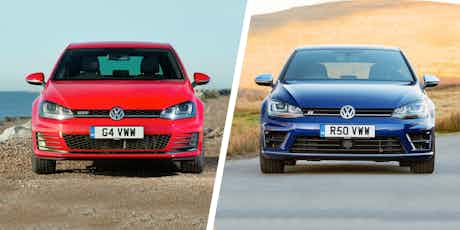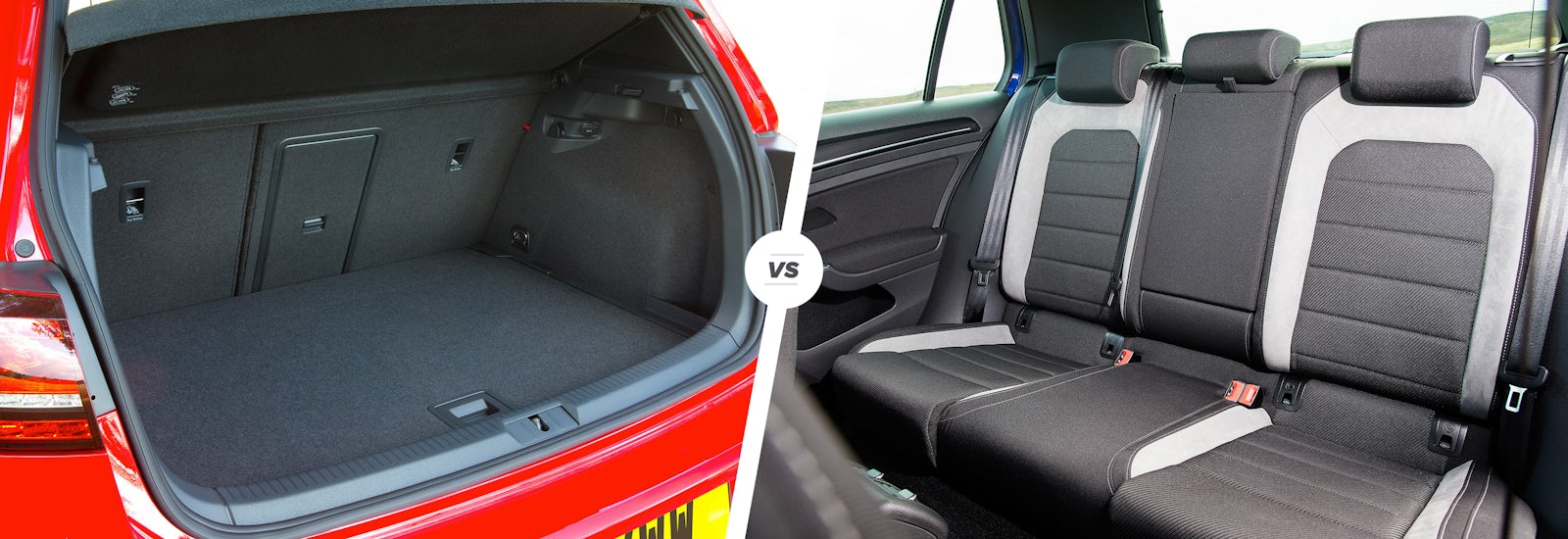Volkswagen Golf GTD vs R – diesel vs petrol
September 25, 2015 by carwow staff

The ever popular Volkswagen Golf comes in formats to suit almost any taste. Need a basic runabout? The entry-level 1.2-litre petrol should fit the bill. Need more oomph? There’s a wide range of petrol and diesel motors to choose from.
The ultimate expression of the Golf is the R. Testers have praised its massive capability and power ever since its release. However, if you’re looking for a taste of the R experience in a cheaper package, the diesel GTD might just hold the answer.
We’ve pitted the Golf brothers against each other to help you decide which hot hatch makes the most sense. Put either the Volkswagen Golf GTD or the Volkswagen Golf R in our car configurator to see how much carwow could help you save. Both models are also offered as estates, read the Golf GTD Estate or Golf R Estate reviews.

Styling

Sitting at the top of the Golf range, the R looks the most dramatic of all. It is still, however, a Volkswagen, so it doesn’t look wild in the same way the Honda Civic Type-R does. The regular five-door Golf’s styling is beefed up thanks to a deep front bumper sporting three gaping air vents, 18-inch alloy wheels (19-inch ones are optionally available) and quad exhaust pipes at the rear. It’s aggressive, but tastefully so.
The GTD is, overall, a less outlandish machine. That isn’t to say it doesn’t look purposeful, though. Indeed, from a distance, the GTD is very close in appearance to the Golf GTI. Look closer, and there are one or two key differences – the stripe running through the front grille is silver rather than the GTI’s red, the alloy wheels are unique to the GTD. The exhaust tips that sit beneath the rear bumper are more subtle than the R’s.
Interior

Step inside, and both cars greet you with a well-built, logically laid out cabin with plenty of storage spaces. The Golf R’s four-wheel-drive system slightly eats into boot space – its 343-litre capacity is down in the GTD’s 380.
Both the GTD and R get extra sporty flourishes to separate them from more basic Golfs. The GTD features supportive sports seats whose centres are trimmed with tartan fabric – a nod to the petrol-powered GTI, and a flat-bottomed leather steering wheel displays GTD badging.
The R, by contrast, has a unique seat design which features marginally more side bolstering to hold the driver and front passenger in place during hard cornering. The most eagle-eyed will notice a few flourishes of piano black and carbon fibre-effect trim dotted about the place, but that’s about as drastic as the differences get.
Driving

Out on the road, the separate character of the two cars becomes more apparent. The R is more firmly sprung than any other model in the Golf range and, as a result, feels incredibly sharp through the bends. It’s never so firm that it’s considered uncomfortable though – there is a real quality to the damping which means it never loses composure, even over large crests. The four-wheel-drive system gives the R with unflappable traction too, making it one of the best cars on sale for covering ground quickly.
The GTD lacks the R’s four wheel drive system, so weighs a full 100kg less. However, the slightly softer, more refined suspension set up means it never feels quite as agile. Those of you who aren’t looking to venture out on the occasional track day or attack every B-road like a rally stage will appreciate the GTD’s smoother ride the rest of the time – that makes it the easier of the two to live with on a daily basis.
Engine

If there’s one thing that testers unanimously agree on, it’s that the Golf R’s performance is immense. The a 296hp 2.0-litre turbocharged unit, in combination with four-wheel drive, takes this practical family hatch from 0-62mph in just 4.9 seconds – that’s quicker than a Jaguar F-Type. It’s impressively flexible, too, meaning it’ll pull hard from any revs.
With a maximum output of 181hp, the GTD is never going to be able to compete with the R in a drag race. A 7.5-second 0-62mph time is still more than adequate to make the GTD feel sporty, though, and the 2.0-litre diesel engine produces the same 280lb ft of torque as the Golf R. As a result, it doesn’t feel as obviously slower in everyday driving, despite what the figures might suggest.
Both the R and the GTD are available with either a six-speed manual or a six-speed dual-clutch automatic gearbox. The latter being a £1,235 option for the R and a £1,415 option for the GTD. The ‘box is controlled via paddles behind the wheel, and trims a tenth or two off the manual cars’ acceleration figures.
Value for money

For the performance, both the R and the GTD seem like bargains. The R costs just over £4,000 more to buy than the diesel but, if you’re happy to lease the R via a Personal Contract Hire (PCH) agreement, there are absolute bargains to be had.
Once the paperwork is out of the way, the GTD will be the cheaper to run on a daily basis. Its diesel engine is achieves 67.3mpg compared to the Golf R’s 40.9, while the insurance group is lower, too (26 vs 34). Aside from the cosmetic differences inside and out, the exhaustive standard equipment list each boast is almost identical.
Verdict

Both of these cars are deeply talented when it comes to doing what they’re designed to do. The Golf R is pitched as the ultimate hot hatchback, and in many ways, it is.
The GTD, on the other hand, aims to offer the driver as taste of the hot hatch experience, while benefitting from lower running costs and a little extra comfort. As sensible sporty family cars go, it’s hard to find a better alternative.
Some people, however, will want to know that they own the ultimate Golf, regardless of how often they’ll make use of its full performance. For those people, the R is the only choice.
What next?
Put either the Volkswagen Golf GTD or the Volkswagen Golf R in our car configurator to see how much carwow could help you save. For more options, visit our deals page or, if you’re still struggling to pick your next car, check out our car chooser.















